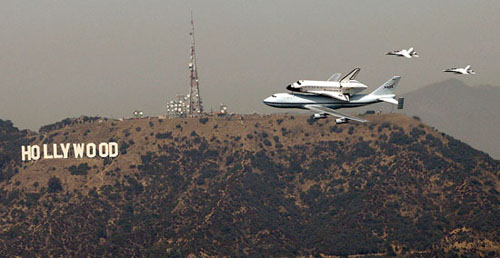Chasing Endeavour
By LIONEL ROLFE
I stood on the banks of the Los Angeles River in order to get a glimpse of Endeavour flying over the southeast end of the Santa Monica Mountains on its way to Griffith Park Observatory.
It would have been much better, of course, to get up to the observatory, a mile or two west of the river bank. Endeavour was scheduled to fly as close to the observatory as it safely could. Whereas here by the river, the precipitous southeastern mountains blocked a direct view of the action around the observatory.
I could walk to the river bank because there was no way I was going to get to the observatory by car before the flyover. I would have been stuck in severe traffic on Los Feliz Boulevard. And all the secluded canyon roads leading up to the observatory were full of adventurous sight-seers trying to get to the top. Naturally there was no way to park near the top once you fought your way there. So I stood there on the banks of the Los Angeles River with others who had come to the river’s bank for the same reasons.
The Los Angeles River flows to the ocean around Griffith Park, which is the southeastern edge of the Santa Monicas, a mountain range that divides Los Angeles proper from the San Fernando Valley suburbs, and then goes north from Topanga and Malibu along the Pacific Coast for several dramatic miles into Ventura County.
As I said, you couldn’t see the observatory from the banks of the Los Angeles River because there was a giant Griffith Park mountain in the way. But you know that it is there–and if Endeavour was going to circle the observatory twice, for sure it would have to fly over the river. It did. It emerged from behind the mountains over the zoo, and then came back a second time.
Our first glimpse was fleeting. At that moment, the sun seemed slightly hazy, and when someone first spotted it, it was coming north out of downtown. It turned and flew west along Los Feliz, away from us.
It emerged over the mountains first over the zoo and then a second time along Los Feliz. Only this time it was Los Feliz going east, toward JPL and Pasadena.
It looked bigger than anything you’d ever expect to see in life.
The way the light was falling on it the third time, it seemed bright and shiny. You couldn’t see the shabbiness of the tiles on the shuttle, all beaten and worn from millions of miles of space travel. You could only see the spic-and-span bottom of the 747, with the second set of wings belonging to the otherwise hidden shuttle.
Everyone got a lump in their throat.
It had the same awe and power that some religious experiences have for the faithful. But it had something more. Here was the power of science–here was a real miracle, not some religious fantasy, but something true and hopeful–a miracle built by the power of human minds and imagination and labor.
Here was this incredible device, a testimony to the liberating power of science, and what government can do when its power for good is unleashed. This is a contraption that wouldn’t exist without science and technology and the combined power of people’s collective will that in a democracy is called government.
Free enterprise would never have built this earthshaking monument to human progress. Oh sure, NASA is now going to turn the further development of space to free enterprise, but free enterprise would never have started this enterprise of going to space in the first place. Free enterprise will never build the great telescopes that can peer deep into the black holes in a universe held together, at least as it’s told by some physicists these days, by musical cords and universal rhythm. But free enterprise can, now that the technology has been developed by the U.S. taxpayers, give joyrides into space for those rich enough to afford them. Perhaps in some ways, the commercialization of space travel will be good. If we’re ever going to mine valuable minerals on other planets, it will no doubt be done commercially–unless it isn’t. But the drive to go to space to learn about the universe we live in–that will never be done by free enterprise.
That great mechanical and electronic creature crawling through a hot summer air that day in Los Angeles was an incredible expression of the best part of us. That was the fact recognized by the people who came out and filled the streets to the brim to watch Endeavor fly over. They understood that this was a glimpse into what our future can be, and perhaps they understood that this is the counterbalance to those forces of darkness wanting to to drown the country in superstitious sloth.
*
Lionel Rolfe is the author of “Literary L.A.,” “Fat Man on the Left,” “The Uncommon Love of Yaltah Menuhin and Willa Cather,” “The Menuhins: A Family Odyssey,” “Bread and Hyacinths: The Rise and Fall of Utopian Los Angeles” and several other volumes available on Amazon’s Kindlestore.




